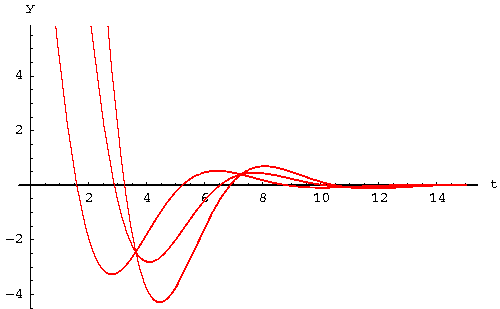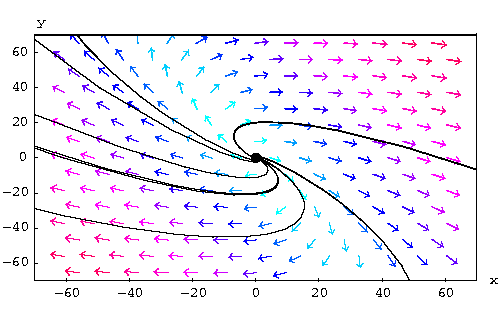 Complex Eigenvalues
Complex Eigenvalues Complex Eigenvalues
Complex Eigenvalues

Consider the linear homogeneous system

The Characteristic polynomial is
![]()
In this section, we consider the case when the above quadratic
equation has complex roots (that is if ![]() ). The
roots (eigenvalues) are
). The
roots (eigenvalues) are

where

In this case, the difficulty lies with the definition of
![]()
In order to get around this difficulty we use Euler's formula
![]()
Therefore, we have
![]()
In this case, the eigenvector associated to ![]() will have complex components.
will have complex components.
Example. Find the eigenvalues and eigenvectors of the matrix
![]()
Answer. The characteristic polynomial is
![]()
Its roots are
![]()
Set  . The
associated eigenvector V is given by the equation
. The
associated eigenvector V is given by the equation ![]() . Set
. Set
![]()
The equation ![]() translates into
translates into
![]()
Since  , then the two
equations are the same (which should have been expected, do you see
why?). Hence we have
, then the two
equations are the same (which should have been expected, do you see
why?). Hence we have ![]() which implies that an
eigenvector is
which implies that an
eigenvector is

We leave it to the reader to show that for the eigenvalue
 , the eigenvector is
, the eigenvector is

Let us go back to the system

with complex eigenvalues ![]() . Note that if V, where
. Note that if V, where
![]()
is an eigenvector associated to ![]() , then the vector
, then the vector
![]()
(where ![]() is the conjugate of v) is an eigenvector associated
to
is the conjugate of v) is an eigenvector associated
to ![]() . On the other hand, we have seen that
. On the other hand, we have seen that
![]()
are solutions. Note that these solutions are complex functions. In order to find real solutions, we used the above remarks. Set
![]()
then we have
![]()
which gives
![]()
Similarly we have
![]()
Putting everything together we get

Clearly this implies ![]() where
where
![]()
It is easy to see that we have
![]()
Since the sum and difference of solutions lead to another solution,
then both ![]() and
and ![]() are solutions of the system. These are real
solutions. It is very easy to check in fact that they are linearly
independent. Let us summarize the above technique.
are solutions of the system. These are real
solutions. It is very easy to check in fact that they are linearly
independent. Let us summarize the above technique.
Summary (of the complex case). Consider the system

![]()
and find its roots

we are assuming that ![]() . Note that at this
step, you need to know
. Note that at this
step, you need to know ![]() and
and ![]() . The common mistake is to
forget to divide by 2.
. The common mistake is to
forget to divide by 2.
![]()
![]()
![]()
where ![]() and
and ![]() are arbitrary numbers. Note that in this case,
we have
are arbitrary numbers. Note that in this case,
we have
![]()
Example. Consider the harmonic oscillator
![]()
Find the general solution using the system technique.
Answer. First we rewrite the second order equation into the system

The matrix coefficient of this system is
![]()
We have already found the eigenvalues and eigenvectors of this matrix. Indeed the eigenvalues are
![]()
Hence we have
![]()
The eigenvector associated to ![]() is
is

Next we write down the two linearly independent solutions

and

The general solution of the equivalent system is
![]()
or

Below we draw some solutions. Notice how the solutions spiral and dye
at the origin (see the discussion below)

|
Since we are looking for the general solution of the differential equation, we only consider the first component. Therefore we have
![]()
You may want to check that the second component is just the derivative
of y.
Below we draw some solutions for the differential equation

|
Qualitative Analysis of Systems with Complex Eigenvalues.
Recall that in this case, the general solution is given by
![]()
The behavior of the solutions in the phase plane depends on the real
part ![]() . Indeed, we have three cases:
. Indeed, we have three cases:

|

|

|

 S.O.S MATHematics home page
S.O.S MATHematics home page 